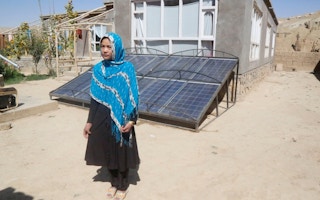The power system of tomorrow will be determined by decisions made today, but time is running out to invest in a brighter and more inclusive future. As the impacts of climate change have become pronounced in the world around us, the financial flows dedicated to climate action have grown.
Great strides have been made in funding large-scale renewable projects in particular, but overall, investment trends remain misaligned with the world’s future needs.
Small scale renewable projects or distributed renewable energy (DRE) have great potential to fill the gap.
Technological breakthroughs in solar cells and battery technologies have accelerated the potential of DREs to bring power to many of the 800 million people who live without electricity, and beyond that to another 2 billion people who continue to suffer from energy poverty globally.
In the wake of the pandemic, a massive scaling up of investments in DREs would help alleviate the immediate jobs crisis by providing local employment and boosting the productivity of businesses.
In the long term, building a new energy system around decentralised renewables will alleviate the climate crisis while building resilience to future impacts. For instance, just replacing kerosene and diesel off-grid power with DRE could annually reduce as much carbon as Germany emits.
At the same time, the scattered, localised nature of DRE systems makes them less vulnerable and more resilient to climate disasters. Take the case of Haiti: After Hurricane Matthew struck in 2016, a company restored DRE grids in under 55 hours while parts of the country went without power for weeks.
Despite these benefits, smaller-scale projects remain critically overlooked by climate investors and policymakers. Only $4.5 billion annually is invested in DREs in low-income and emerging markets. To achieve meet the needs of the 800 million people with no access to power, investments must reach $17.5 billion annually over the next 10 years.
Barriers to financing DRE
There is widespread recognition that distributed renewables are often the least-cost option to provide energy access in a climate protective way. So why do DREs not get a bigger slice of the climate finance pie?
A major reason is that decentralised projects are small in size. Smaller investments in multiple projects increase the administrative and monitoring costs for funders compared to a single large project.
Individually, DRE projects yield relatively small amounts of emission reductions, so the cost of generating carbon offsets could be more than the benefits provided by carbon finance.
Unfavourable policy and regulations, such as tax and subsidies regimes favouring fossil fuels, are also a deterrent.
Indonesia’s state utility company, for instance, prioritised grid extension for rural electrification despite it being a more expensive alternative than off-grid renewables for the country’s geography.
Many power system planners remain trapped in yesterday’s power paradigm, which revolves around large centralised fossil fuel plants, which are often easier to finance and build, despite the fact that these sources of power are highly financially risky and will doom the planet.
But as some nations and initiatives have shown, there are creative ways to overcome these challenges and channel more climate finance into DRE.
Solutions
One approach to addressing these bottlenecks is the aggregation of DRE projects to make them more attractive for funders.
GreenStreet Africa, a climate finance instrument launched in September 2020, is a step in this direction. It bundles distributed solar projects to achieve the big-ticket sizes that institutional investors prefer.
There have also been attempts to reduce costs by using blockchain to digitise manual monitoring of decentralised projects, such as Distributed Digital Impact Gains. This innovation could also allow carbon offsets from various sources to be bundled together or monetised separately.
These measures, however, can effectively finance DRE only in the presence of an enabling policy and regulatory framework. The “success story” of Bangladesh is instructive in this regard.
Its state-owned agency, Infrastructure Development Company Limited (IDCOL), funnels finance from various sources into multiple small projects. It provides a mix of grants and loans to businesses, households, and intermediaries such as microfinance institutions. Aggregation of projects through IDCOL reduces the administrative costs for funders.
The central bank of Bangladesh provides a regulatory push and incentivises commercial banks to lend to green investments through access to low-interest capital.
These measures were successful in financing the installation of 4.1 million solar home systems by December 2016. It is estimated that the consequent reduction in kerosene use saved 1.5 million tonnes CO2e a year – equivalent to taking passenger cars off roads for 3.5 billion miles.
The way forward
Changing economic fundamentals mean that the goals of ending energy poverty, combating climate change and driving inclusive growth are not just aligned, they have become mutually reinforcing.
Given the billions that will be allocated to power infrastructure over the Covid-19 recovery period, imminent investment decisions will have a decisive impact on whether the world has a chance of meeting these interconnected objectives.
As Bangladesh’s experience shows, efficient deployment of capital for DREs can achieve spectacular results. We must build on these best practices and make them global. An important first step is to better communicate the benefits of DREs to climate funders and government, not least at the major climate conference in Glasgow at the end of this year.
Joseph Curtin is the Director of Power & Climate Initiative at The Rockefeller Foundation and Deepali Khanna is the Managing Director of Asia Regional Office at The Rockefeller Foundation.










